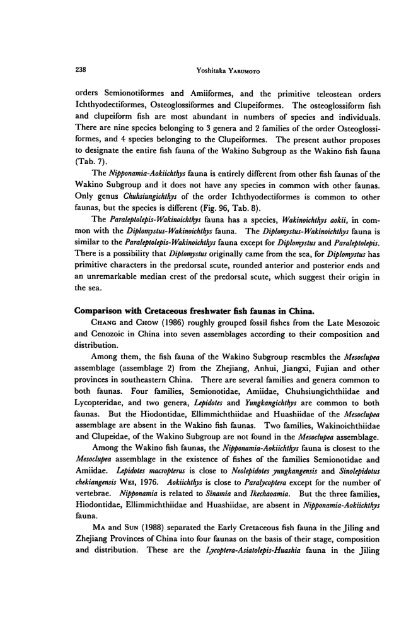Early Cretaceous Freshwater Fish Fauna in Kyushu, Japan
Early Cretaceous Freshwater Fish Fauna in Kyushu, Japan
Early Cretaceous Freshwater Fish Fauna in Kyushu, Japan
Create successful ePaper yourself
Turn your PDF publications into a flip-book with our unique Google optimized e-Paper software.
238 Yoshitaka Yabumoto<br />
orders Semionotiformes and Amiiformes, and the primitive teleostean orders<br />
Ichthyodectiformes, Osteoglossiformes and Clupeiformes. The osteoglossiform fish<br />
and clupeiform fish are most abundant <strong>in</strong> numbers of species and <strong>in</strong>dividuals.<br />
There are n<strong>in</strong>e species belong<strong>in</strong>g to 3 genera and 2 families of the order Osteoglossi<br />
formes, and 4 species belong<strong>in</strong>g to the Clupeiformes. The present author proposes<br />
to designate the entire fish fauna of the Wak<strong>in</strong>o Subgroup as the Wak<strong>in</strong>o fish fauna<br />
(Tab. 7).<br />
The Nipponamia-Aokiichthys fauna is entirely different from other fish faunas of the<br />
Wak<strong>in</strong>o Subgroup and it does not have any species <strong>in</strong> common with other faunas.<br />
Only genus Chuhsiungichthys of the order Ichthyodectiformes is common to other<br />
faunas, but the species is different (Fig. 96, Tab. 8).<br />
The Paraleptolepis-Wak<strong>in</strong>oichthys fauna has a species, Wak<strong>in</strong>oichthys aokii, <strong>in</strong> com<br />
mon with the Diplomystus-Wak<strong>in</strong>oichthys fauna. The Diplomystus-Wak<strong>in</strong>oichthys fauna is<br />
similar to the Paraleptolepis-Wak<strong>in</strong>oichthys fauna except for Diplomystus and Paraleptolepis.<br />
There is a possibility that Diplomystus orig<strong>in</strong>ally came from the sea, for Diplomystus has<br />
primitive characters <strong>in</strong> the predorsal scute, rounded anterior and posterior ends and<br />
an unremarkable median crest of the predorsal scute, which suggest their orig<strong>in</strong> <strong>in</strong><br />
the sea.<br />
Comparison with <strong>Cretaceous</strong> freshwater fish faunas <strong>in</strong> Ch<strong>in</strong>a.<br />
Chang and Chow (1986) roughly grouped fossil fishes from the Late Mesozoic<br />
and Cenozoic <strong>in</strong> Ch<strong>in</strong>a <strong>in</strong>to seven assemblages accord<strong>in</strong>g to their composition and<br />
distribution.<br />
Among them, the fish fauna of the Wak<strong>in</strong>o Subgroup resembles the Mesoclupea<br />
assemblage (assemblage 2) from the Zhejiang, Anhui, Jiangxi, Fujian and other<br />
prov<strong>in</strong>ces <strong>in</strong> southeastern Ch<strong>in</strong>a. There are several families and genera common to<br />
both faunas. Four families, Semionotidae, Amiidae, Chuhsiungichthiidae and<br />
Lycopteridae, and two genera, Lepidotes and Yungkangichthys are common to both<br />
faunas. But the Hiodontidae, Ellimmichthiidae and Huashiidae of the Mesoclupea<br />
assemblage are absent <strong>in</strong> the Wak<strong>in</strong>o fish faunas. Two families, Wak<strong>in</strong>oichthiidae<br />
and Clupeidae, of the Wak<strong>in</strong>o Subgroup are not found <strong>in</strong> the Mesoclupea assemblage.<br />
Among the Wak<strong>in</strong>o fish faunas, the Nipponamia-Aokiichthys fauna is closest to the<br />
Mesoclupea assemblage <strong>in</strong> the existence of fishes of the families Semionotidae and<br />
Amiidae. Lepidotes macropterus is close to Neolepidotes yungkangensis and S<strong>in</strong>olepidotus<br />
chekiangensis Wei, 1976. Aokiichthys is close to Paralycoptera except for the number of<br />
vertebrae. Nipponamia is related to S<strong>in</strong>amia and Ikechaoamia. But the three families,<br />
Hiodontidae, Ellimmichthiidae and Huashiidae, are absent <strong>in</strong> Nipponamia-Aokiichthys<br />
fauna.<br />
Ma and Sun (1988) separated the <strong>Early</strong> <strong>Cretaceous</strong> fish fauna <strong>in</strong> the Jil<strong>in</strong>g and<br />
Zhejiang Prov<strong>in</strong>ces of Ch<strong>in</strong>a <strong>in</strong>to four faunas on the basis of their stage, composition<br />
and distribution. These are the Lycoptera-Asiatolepis-Huashia fauna <strong>in</strong> the Jil<strong>in</strong>g

















